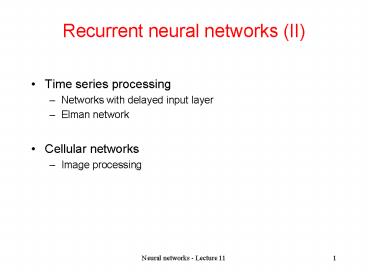Recurrent neural networks II - PowerPoint PPT Presentation
1 / 20
Title:
Recurrent neural networks II
Description:
The prediction (forecasting) is based on a model which describes the dependency ... Half-toning (gray level image - binary image) Gap filling in binary images ... – PowerPoint PPT presentation
Number of Views:229
Avg rating:3.0/5.0
Title: Recurrent neural networks II
1
Recurrent neural networks (II)
- Time series processing
- Networks with delayed input layer
- Elman network
- Cellular networks
- Image processing
2
Time series
- Time series sequence of values measured at
successive moments of time - Examples
- Currency exchange rate evolution
- Stock price evolution
- Biological signals (EKG)
- Aim of time series analysis predict the future
value(s) in the series
3
Time series
- The prediction (forecasting) is based on a model
which describes the dependency between previous
values and the next value in the series.
Order of the model
Parameters corresponding to external factors
4
Time series
- The model associated to a time series can be
- Linear - Nonlinear
- Deterministic - Stochastic
Example autoregressive model (AR(p))
noise random variable from N(0,1)
5
Time series
- Neural networks. Variants
- The order of the model is known
- Feedforward neural network with delayed input
layer - (p input units)
- The order of the model is unknown
- Network with contextual units (Elman network)
6
Networks with delayed input layer
Architecture
Functioning
7
Networks with delayed input layer
- Training
- Training set ((xl,xl-1,,xl-p1),xl1)l1..L
- Training algorithm BackPropagation
- Drawback needs the knowledge of p
8
Elmans network
- Architecture
Contextual units
Functioning
Rmk the contextual units contain copies of the
outputs of the hidden layers corresponding to the
previous moment
9
Elmans network
- Training
- Training set (x(1),x(2)),(x(2),x(3)),(x(t-1),
x(t)) - Sets of weights
- Adaptive Wx, Wc si W2
- Fixed the weights of the connections between the
hidden and the contextual layers. - Training algorithm BackPropagation
10
Cellular networks
- Architecture
- All units have a double role input and output
units - The units are placed in the nodes of a two
dimensional grid - Each unit is connected only with units from its
neighborhood (the neighborhoods are defined as in
the case of Kohonens networks) - Each unit is identified through its position
p(i,j) in the grid
virtual cells (used to define the context for
border cells)
11
Cellular networks
- Activation function ramp
Notations Xp(t) state of unit p at time
t Yp(t) - output signal Up(t) control
signal Ip(t) input from the environment apq
weight of connection between unit q and unit
p bpq - influence of control signal Uq on unit p
12
Cellular networks
Signal generated by other units
- Functioning
Control signal
Input signal
- Remarks
- The grid has a boundary of fictitious units
(which usually generate signals equal to 0) - Particular case the weights of the connections
between neighboring units do not depend on the
positions of units - Example if p(i,j), q(i-1,j), p(i,j),
q(i-1,j) then - apq apqa-1,0
13
Cellular networks
- These networks are called cloning template
cellular networks - Example
14
Cellular networks
- Illustration of the cloning template elements
15
Cellular networks
- Software simulation equivalent to numerical
solving of a differential system (initial value
problem) - Explicit Euler method
- Applications
- Gray level image processing
- Each pixel correspond to a unit of the network
- The gray level is encoded by using real values
from -1,1
16
Cellular networks
- Image processing
- Depending on the choice of templates, of control
signal (u), initial condition (x(0)), boundary
conditions (z) one arrive to different image
processing tasks - Half-toning (gray level image -gt binary image)
- Gap filling in binary images
- Noise elimination in binary images
- Edge detection in binary images
17
Cellular networks
Example 1 edge detection z-1, Uinput image,
h0.1
http//www.isiweb.ee.ethz.ch/haenggi/CNN_web/CNNsi
m_adv.html
18
Cellular networks
- Example 2 gap filling
- z-1,
- Uinput image,
- h0.1
19
Cellular networks
- Example 3 noise removing
- z-1, Uinput image, h0.1
20
Cellular networks
- Example 4 horizontal line detection
- z-1, Uinput image, h0.1































